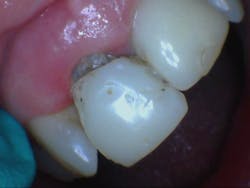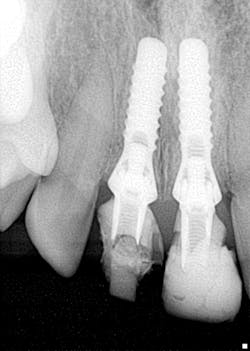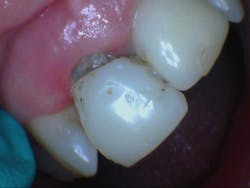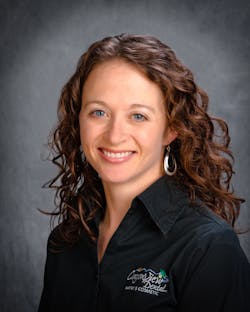BROKEN TEETH AND FILLINGS ... “My crown came off” ... “I have an abscessed tooth” ... these are some of the par-for-the-course calls that we all get from patients who need a quick look/quick fix to get their issues resolved in one way, shape, or form. More often than not, these are usually the patients who only go to the dentist when something goes wrong. Am I right?
So, when a healthy 61-year-old female called, stating she just moved to the area and the temporary on her implant was moving around, I thought two things: (1) a loose screw, and (2) the timing of her move must have crossed with the integration process for the fabrication of her definitive restoration. No biggie. I’ve got it. I’ll fix the temporary (which was her front tooth), contact her previous dentist, and proceed as indicated for long-term care. Win-win.
My front desk is amazing. They are hands down the best and called ahead of time to the patient’s previous dentist to get the specifics for the implant system, etc. Apparently, the implants on Nos. 8 and 9 were placed 12 years ago due to an accident the patient sustained; the provisionals were immediately fabricated and were the same ones that broke! Yes, I said that right, 12 years! I was conflicted, thinking that was a looooong time for implants to integrate prior to putting a definitive restoration on, yet also realizing that there are two sides to every story.
A simple introduction to the patient led us into a discussion about her situation. An unsympathetic kicking horse, broken front teeth, surgery, implants, and temporaries were the jubilee of things that had happened in a very short period of time. According to her, there was no other option given, and since then, her temporaries had been in service with a few repairs now and then. Other unexpected financial obligations and time commitments left absolutely no wiggle room to commence with the definitive crowns. Insert #lifehappens here. All that aside, her current dental status quo needed fixing.
A quick radiographic assessment revealed missing coronal tooth structure/temporary material on No. 8 and rough edges for No. 9 (figure 1). Clinically, the temporary had broken resin on the buccal of the temp coping and was barely hanging on by a thread. Plaque and debris were heavy, accompanied by a fetid odor (figure 2).
Figure 1: Implants 8 and 9 with temps
The implant system used was Straumann. The access point was on the lingual...somewhere...so, I just went for it. I drilled, and drilled, and drilled, and after 12 mm of making my way through resin (talk about a pain!), I found the tiiiiiny piece of Teflon that was covering the screw, but I couldn’t get it out! Since there was a void on the buccal, I was able to pull it out through the coping where the resin had broken off. I know...totally unconventional, but it worked! I was finally able to lock the driver in and release the implant (figure 3).
Figure 3: Temporary once removed
After repairing and cleaning everything up, the patient was dismissed with a conversation about moving forward with a complete assessment to establish her as a new patient. Restoring her implants was touched upon, and I also encouraged her to speak with my office manager about potential financing opportunities. She left in good spirits and was smiling because she could. Her tooth was fixed.
There are a few lessons and points to be made with this case, all of which have arguments that can be played out on both sides of the fence.
1. A lot of the time we don’t feel like our patients understand the importance of their dental care, taking care of their oral health, and moving forward with our recommendations. After all, we are the doctors, and we only have their best interests at the forefront of our concern. Or do we?
2. Temporaries for 12 years? Did the previous dentist truly not offer another alternative or stress the problems that could occur with being in temporaries for so long? Perhaps the dentist did, and if that is the case, I refer back to point No. 1.
3. The patient was fully aware that she was overdue for definitive restorations, but that was not her chief complaint. Her reason for calling my office was because she couldn’t smile. We fix that, we gain her confidence, we bring her back for a full assessment, and we have a happy and long-term patient.
4. Sometimes we have to be creative and go outside the box to fix something. Necessity is the mother of invention, and I’ll submit that as a collective profession, we are the masters of creativity with some of the things we are asked to fix, especially on the fly. Does this compromise standards? Perhaps, if you go by the textbook 111% of the time. However, as long as we are clear about our limitations and discuss the risks, benefits, and alternatives, we have some leeway to make a fix and then plan for more permanent care.
5. Sometimes we have to be understanding and show empathy for what our patients are going through outside our offices and their dental care needs. Their oral health does not compromise their entire life. With that being said, we can certainly stress how oral health (or the lack thereof) can impact their life, especially when small issues are not resolved and subsequently turn into larger, more urgent concerns.
What has since happened with this patient? Well, she’s getting her definitive crowns fabricated! A little TLC, confidence boosting, and creative financing have allowed her to complete what she always knew needed to get done. And, as Paul Harvey so eloquently put it, “And now you know the rest of the story.”
Keep on keepin’ on, my friends!
Stacey
Stacey L. Gividen, DDS
Editorial Director, Breakthrough Clinical
LAST MONTH >> Not on my watch!
Read more clinical dentistry articles at this link.
Editor's note: This article originally appeared in Breakthrough Clinical, a clinical specialties newsletter from Dental Economics and DentistryIQ.
About the Author
Stacey L. Gividen, DDS
Stacey L. Gividen, DDS, a graduate of Marquette University School of Dentistry, is in private practice in Montana. She is a guest lecturer at the University of Montana in the Anatomy and Physiology Department. Dr. Gividen has contributed to DentistryIQ, Perio-Implant Advisory, and Dental Economics. You may contact her at [email protected].





